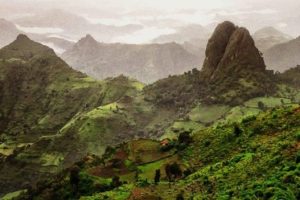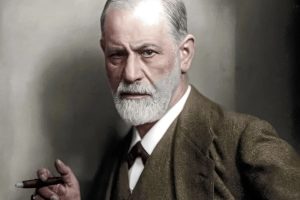
Artist Yadesa Zwege Bojia was born in West Showa Asgori city in the Oromia State of Ethiopia. He is the eighteenth child born after eight sons and nine daughters. His father was noted for playing a major role in the Oromo Tulama struggle. When his father was killed along with his friend, Yadesa ran away from home and began to live in Addis Ababa at a young age.
He attended primary school at Yekatit 23. He was an outstanding school and scored high marks in the eighth-grade national exam, so he attended Addis Ketema High School.
Although Yadesa believes that it is not wise to compete, but to learn; He spent his childhood in racing. Later, he joined Addis Ababa University College of Commerce. He earned his bachelor’s degree in accounting. Yadesa, entered the United States after completing his university studies; But when he went to America, he quitted accounting and studied design at Seattle University.
Yadesa Zewge Bojia let Ethiopia’s name be raised via his works by designing the emblem of the African Union. He is our guest.
Could you brief us on what your childhood looked like?
Although my family was very well off; I grew up leading a troublesome life. Since our father was killed and our house was confiscated, we were forced to live on aids. Growing up in adversity, I learned that greatness is not measured by wealth. So I measured people in terms of their personalities.
I am the eighteenth child of my house. Only Gash Goruku the eldest child of the house was born from another mother. The other eighteen of us were born from same parents.
When did you realize art is your calling and start translating it into action?
My passion for art is boundless. But they could not study art in Ethiopia. As soon as I completed grade 12, I was assigned to Town Planning College. But they declined to take me up claiming it is not possible because my grade in mathematics was “B”. So I was denied the chance and instead studied accounting. But as soon as I went to America, I studied fine art.
Fine art presupposes generating ideas from oneself; and commercial art is designing and drawing to meet the needs of the buyer, not one’s feelings. By mastering these two, I was able to kill two birds with a stone. What I do now is not only confined to my work; I juggle different jobs. I did the African Union’s logo in the same way.
While I was in Ethiopia, as a child I used to practice painting. I decorated hotels. When I was still in elementary school I drew a picture with a caption, “I will be like my father.” The picture is of wartime, so the father is dressed in military uniform and the son is standing next to him. So, I would try.
People knew this, so they looked for me to give me information. People used to tip me with ideas of wonderful designs. But since I was a student, I didn’t take the tips seriously.
Can we say that your childhood is entirely permeated by art?
When I was a kid I used to sing a song in Afan Oromo language. At that time, people did not sing much that way. It wasn’t that common for me to sing a song called Gangen Oromo in Oromo as a child in the top six. My brother wrote the song lyrics. The song posed the question of what the fate of the Oromo people will be. I sang the song without contemplating it.
The contents of the songs mostly revolved around my country. If I include my own story, I was pushed out of my country; I sang a song called I will not forget my country. Even if I sing in any language, whether in Amharic or any other language, I will never forget respecting my Oromoness. We cannot be one another’s enemies.
Language doesn’t matter. For example, not because he speaks Oromo, but as an Amhara, he can speak Oromo. There is such a thing as intimacy. I consider everything that I have been through as a blessing. I enjoy knowing and learning.
What did you further practice in art after you went to America?
Yes! I designed the logos many hotels. I created corporate accounts as well as websites. I have worked for many people in commercial art. I have also exhibited in many galleries at Fine Art.
When the name Yadesa is raised, the logo of the African Union is mentioned. What initiated you to design the AU logo?
In the past, when a big design request came up, people informed me to compete. I participated in many of them. But when I saw this, I really wanted and thought about it, so I took my time and studied about the Organization of African Union (OAU) first. They wanted Africa to be portrayed as a country. It was the African Union (AU) but it had to be separated. I studied that well. When we competed, they wanted it to be like a country.
What activities are you undertaking to promote the country’s culture and art?
A sense of possibility dawned on me. If Addis Ababa is able to grow and come up with allurements everyone can do it. The contagiousness of this spirit to everyone is great. People will learn more than me. I believe that it will be respected.
What are you doing to promote the country’s culture and art?
I have various pictures related to Irrecha. I have a very famous painting. I also have an award-winning song I wrote about a woman from Ambo. The song is famous in America.
Sunday is the day of Irrecha
Glittering charming girl like light
Trek to Bishoftu
Pray for peace…. .
This shows how and why a young Irrecha went from Ambo to Bishoftu to celebrate and died. I believe that marking Irrecha is a fundamental right of the Oromo. Respecting culture is also good for the country. It will set a lesson for the coming generations. So I can mention this among what I have done in terms of promoting culture through art.
Have you ever participated in an Irrecha since you started living abroad?
Yes, we were celebrating Irrecha in America, so I have been participating year after year.
Apart from the painting picture, is it possible to expect you as a singer?
Why not? Artistry is about generating ideas though it is also expressed in paintings, song, and other works of art. Expressing our ideas differently allows our ideas to be more influential.
How many songs have you sung?
The album consists of twelve songs. I also have four singles. And now I have a new English song. I just did it recently; I didn’t promote it in a profound fashion. I have three songs in Oromo.
What do you plan to do in the future with art?
I got a lot for myself. But now I think about the people. Therefore, I am making an effort to educate children in cooperation with the Oromia Regional State. In the future, requesting land I will take a place and open a gallery where children can learn. I want others to find what I could not find while living in this country. It takes a lot of resources and property to open another school. I believe that if I get such help, I will let the country unleash young talents.
How long have you been in America?
I have been there for twenty-nine years and I came in 2012 for a wedding.
BY MENGISTAB TESHOME
THE ETHIOPIAN HERALD FRIDAY 29 NOVEMBER 2024





